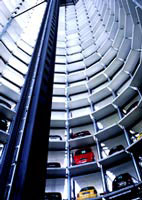The devil is in the retail
Hannah Booth looks at a book showcasing retail design worldwide, and discovers that we’re all just being manipulated to part with our money

Popping out for socks is so 20th century. Nowadays, if former design consultant Otto Riewoldt is to be believed, shopping is no longer an innocent pastime, it’s a full-on, in-yer-face “experience”. Marks & Spencer, set to close 20 branches, could do well to heed his advice. Retail Design, Riewoldt’s engaging new book, designed by Frank Philippin and published by Laurence King, showcases sexy retail environments to examine how they are upping the design stakes to fend off the evils of Internet shopping.
It’s simple, says Riewoldt. The “irresistible attraction” of e-commerce is pressurising retailers to excite consumers, and the traditional shop is now an irresistible blank canvas for designers. They must “fill empty shop spaces with life”, and create arenas where shopping meets entertainment, he says. Nothing new there, you might think. But Riewoldt identifies a more worrying trend – retailers’ “psychology of persuasion”. Wandering aimlessly around a department store is, in fact, a conditioned exercise, whereby “strolling is exploitable for the purpose of selling merchandise”. We are unsuspecting pawns, being rudely manipulated into parting with our cash.
Take the Levi’s flagship store in London’s Regent Street, designed by Checkland Kindleysides in 1999. Once the manufacturer realised it couldn’t sell jeans to today’s jaded Generation X on 1950s nostalgia alone, it turned its San Francisco and London stores into hedonistic branded palaces, with DJ towers, chill-out zones, Internet terminals and temporary art exhibitions. Oh, and if you look very hard, jeans.
Similarly, Hosker Moore & Kent’s 1998 interiors for Moschino in London had to reflect the founder’s passion for kitsch, but not alienate the label’s more well-heeled clientele. The result is “pop baroque” stores, contrasting elegant couture displays with ironic window displays lined with mock Financial Times pages for the funkier products. With both, merchandise takes a back seat.
The outlandish is taken to postmodern extreme with Dougall Design Associates’ giant Trojan Horse at the entrance to US toy shop FAO Schwartz in Dougall’s frighteningly taste-free Las Vegas shopping mall, The Forum. Even Volkswagen had its tongue in cheek when it commissioned Henn Architekten to create an entire Autostadt – car town – near Wolfsburg in Germany. Cars awaiting collection are stacked in a 42m-high glass tower with a central fork-lift pole, which wouldn’t look out of place in a James Bond film.
The Internet cannot seriously compete with these types of extreme retail environments, or replicate the touchy-feeliness of actual clothes shopping. Those with more to fear are bookshops because the feel of a book is, to most, unimportant and the likes of Amazon.com have proved more serious rivals. As a result, creating a relaxing in-store ambience is everything. BDG McColl’s interiors for Waterstone’s megastore in London’s Piccadilly features leather armchairs, lounge and juice bars, ubiquitous Internet stations and a restaurant.
The concept of making shopping more pleasurable must be welcomed. But in their philosophy, retail “experiences” are no different to plain old shops – they want people to part with their money. Do Internet cafés, juice bars and DJs go further in achieving that? Do beautiful interiors promise what the goods cannot match? If so, we will surely end up back at square one, where merchandise rules, irrespective of interior design.
The depressing truth is that, as the trend towards homogeneity grows, high streets the world over will look identical. You can kiss goodbye to the independent, treasure-trove bookshop, and popping out for socks will become an endurance test for the brave.
Retail Design by Otto Riewoldt will be published in mid-November by Laurence King Publishing, priced £45
-
Post a comment




